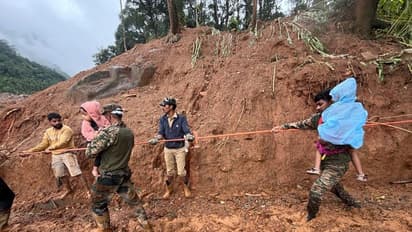29 taluks of Malnad and coastal Karnataka face landslide risk; urgent action needed

Synopsis
Karnataka is at high risk of landslides in 29 taluks across Malnad and coastal regions. Despite a 2022 action plan, the government has failed to implement adequate measures. Landslides surged from 27 in 2009 to 462 in 2018, with 1,272 recorded between 2009 and 2021. The situation worsens with heavy rains causing frequent landslides.
Karnataka is facing a serious threat of landslides across 29 taluks in its Malnad and coastal regions. Despite the State Disaster Management Authority's 2022 action plan aimed at managing landslides, the government has yet to implement sufficient measures to address the growing risk.
According to the action plan, the state was expected to take proactive steps to prevent landslides, particularly during the rainy season. Unfortunately, this plan has not been adequately executed. In 2022 alone, heavy rains triggered landslides in 55 locations throughout the state. The situation improved slightly in 2023 with only two incidents, thanks to reduced rainfall. However, the current heavy rains have caused landslides in over 16 places, with fears of more to come if the government does not act swiftly.
Wayanad landslides: Heart-wrenching videos of long convoy of ambulances carrying dead bodies surface (WATCH)
1,272 landslides in 13 years!
From January 2009 to December 2021, Karnataka experienced 1,272 landslides, causing significant damage. The frequency of these landslides has surged in recent years, particularly in Uttara Kannada and Shimoga districts. In 2009, the state recorded only 27 landslides. This number jumped to 125 in 2016, 219 in 2017, 462 in 2018, 161 in 2019, and 264 in 2020. The peak was in 2018 with 462 landslides. Over the past 13 years, Uttara Kannada alone has seen 439 landslides.
State government's negligence
The State Action Plan for Landslide Management, formulated in 2022, outlines several crucial measures. These include identifying high-risk areas, constructing barriers, relocating residents from dangerous zones, coordinating quickly with various departments during landslides, updating the action plan annually, and conducting geological studies in at-risk areas. Regrettably, these recommendations have largely been ignored, leading to an increase in landslides.
Several factors contribute to the risk of landslides in Karnataka. These include thin soil cover on steep hills, changes in landforms, heavy rainfall, obstruction of natural water flow, and the construction of temporary dams in natural channels. Additionally, deforestation in hilly and sloping areas exacerbates the problem.
Hill collapses on Bengaluru-Mangaluru NH75 due to heavy rainfall in Shiradi ghat, vehicles stuck
The taluks most prone to landslides include:
Uttara Kannada: Ankola, Honnavara, Karwara, Kumata, Siddapur, Shirsi, Supa, Yallapur
Udupi: Hebri, Karkala, Byndur, Kundapur
Shivamogga: Theerthahalli, Sagara, Hosanagar
Kodagu: Madikeri, Somwarpet, Virajpet
Dakshina Kannada: Belthangadi, Bantwala, Mangaluru, Kadaba, Sulya, Puttur
Chikkamagaluru: Chikkamagaluru, Mudigere, NR Pura, Sringeri
Hassan: Sakaleshpur
From 2009 to 2021, the distribution of landslides was as follows: 439 in Uttara Kannada, 356 in Shivamogga, 193 in Chikkamagaluru, 99 in Udupi, 88 in Dakshina Kannada, 79 in Kodagu, and 18 in Hassan.
Stay updated with the Breaking News Today and Latest News from across India and around the world. Get real-time updates, in-depth analysis, and comprehensive coverage of India News, World News, Indian Defence News, Kerala News, and Karnataka News. From politics to current affairs, follow every major story as it unfolds. Download the Asianet News Official App from the Android Play Store and iPhone App Store for accurate and timely news updates anytime, anywhere.